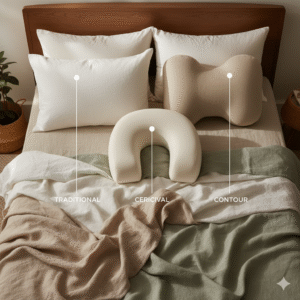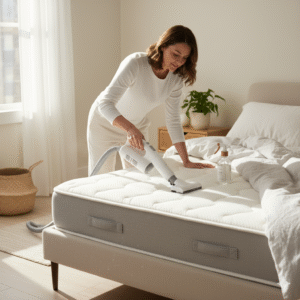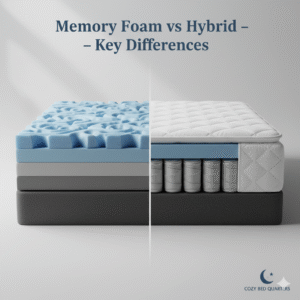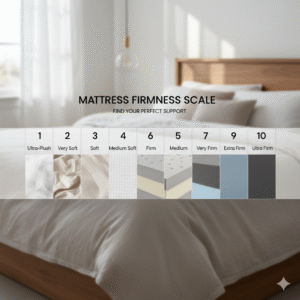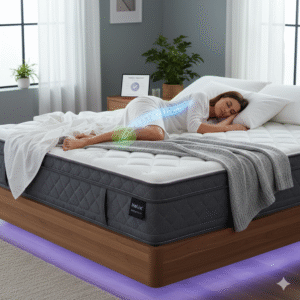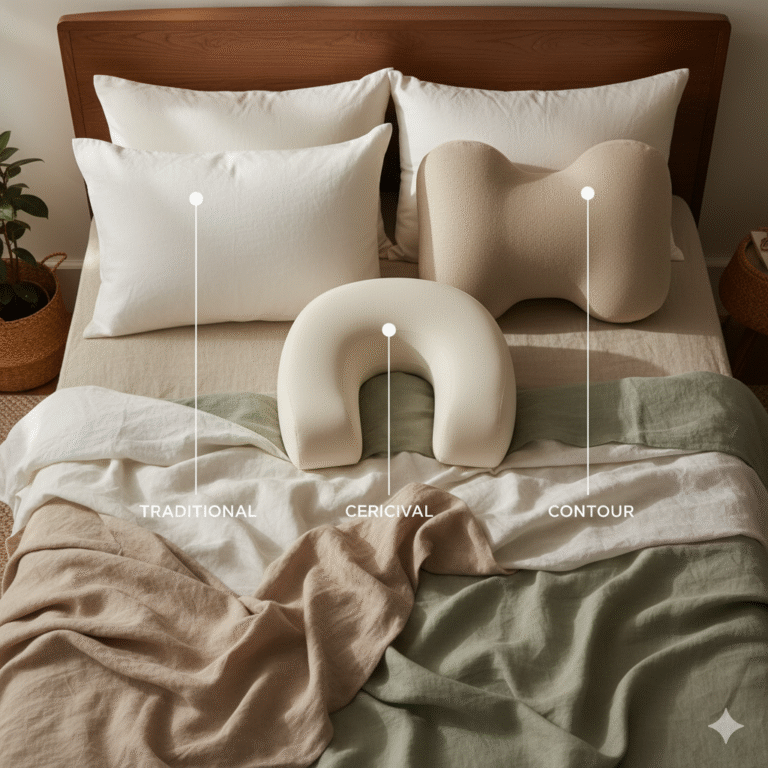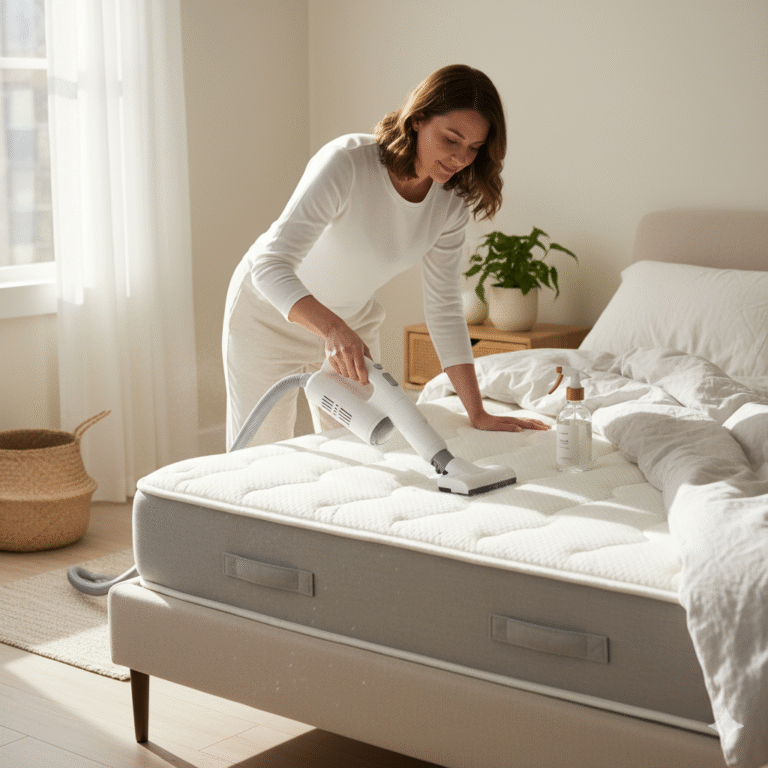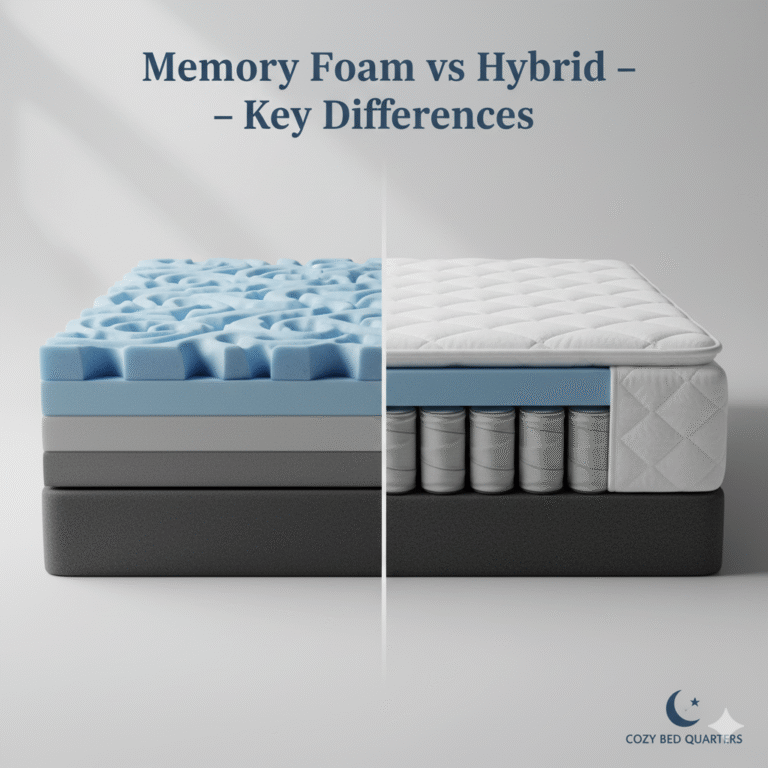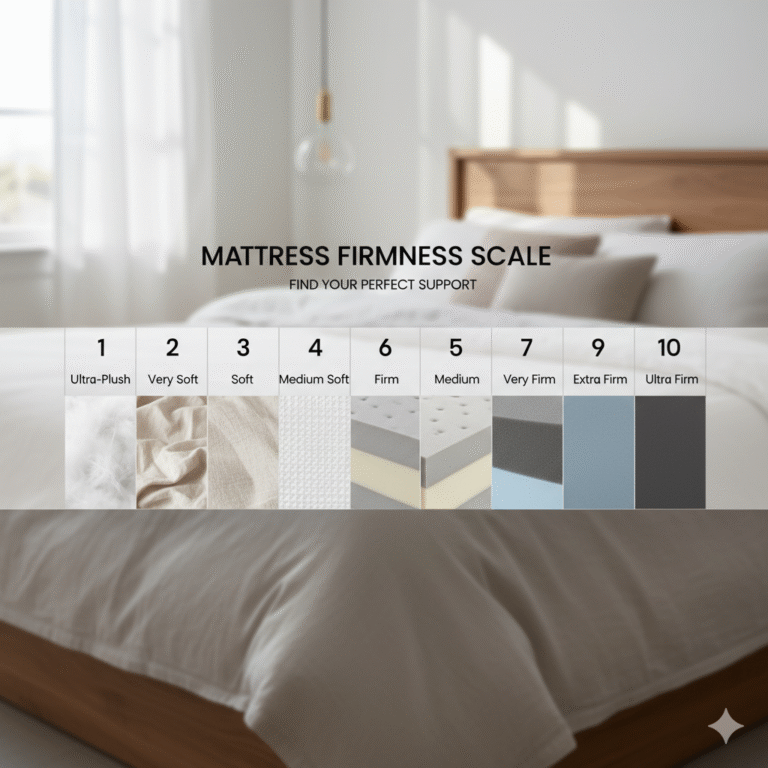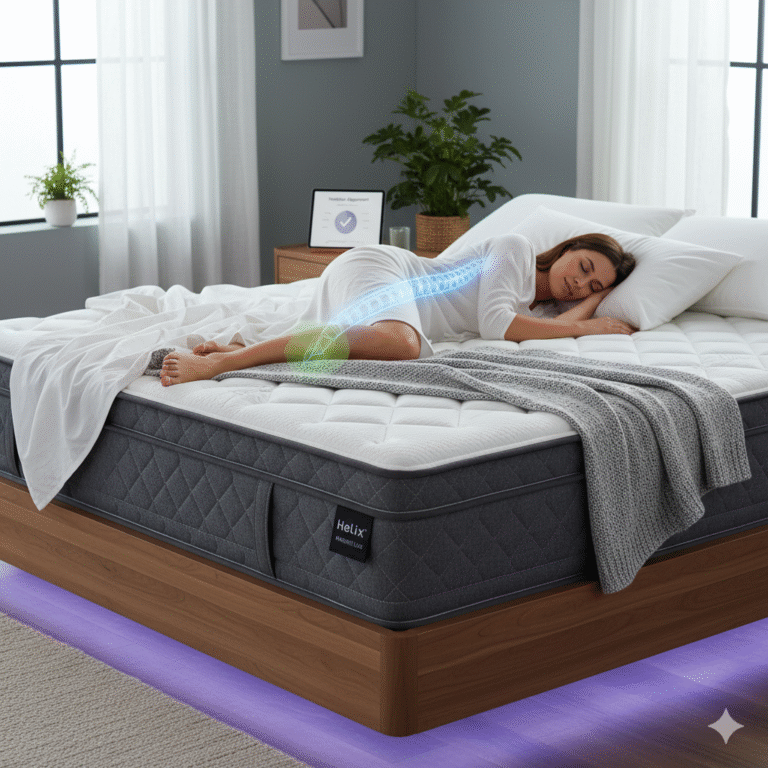Choosing Pillows for Comfort and Better Sleep
When it comes to choosing pillows for comfort, the right pick keeps your head, neck, and spine aligned so you wake up refreshed instead of stiff. In this guide, you’ll learn how to match materials, loft, and features to your sleep style, plus how to spot quality so your pillow supports you night after night.
Key Takeaways: choosing pillows for comfort
- Match loft and firmness to sleep position. Side sleepers typically need higher, firmer loft; back sleepers do best with medium; stomach sleepers need the thinnest support.
- Material = feel + support + care. Memory foam contours, latex is buoyant and breathable, down is plush, and down alternative is hypoallergenic and easy-care.
- Prioritize alignment first. The best results when choosing pillows for comfort come from keeping ears, shoulders, and hips in a straight line.
- Look for adjustability and cooling if you toss or sleep hot. Shredded foam, removable inserts, and cooling covers help fine-tune comfort.
- Quality shows in construction and certifications. Seek reputable labels (e.g., CertiPUR-US®, GOTS, GOLS, OEKO-TEX®) and durable stitching.
The Importance of Support in Pillow Selection
Answer first: Proper support keeps your spine neutral so muscles can relax and heal overnight.
At its core, choosing pillows for comfort means finding a height and firmness that cradles your head without letting it tilt. A neutral neck reduces morning aches and headaches and can even lessen snoring by helping your airway stay open.
Answer first: Replace pillows when they flatten, fold, or feel lumpy.
If you’re constantly scrunching for extra loft or notice flat spots, it’s time to retire that pillow. Most pillows last 1–2 years; premium latex or high-density foams can last longer with care.
Answer first: Simple care extends comfort and lifespan.
Use a breathable protector and wash pillowcases weekly. Fluff down/alternatives, and follow manufacturer care for foam or latex. For bedding add-ons that amplify comfort, see our bed accessories guide.

Popular Pillow Materials and What They Feel Like
Answer first: Your fill dictates feel, temperature, and upkeep.
Materials matter when you’re choosing pillows for comfort. Each fill has a distinct balance of contour, bounce, breathability, and maintenance.
Memory Foam
Fast take: Contouring support that relieves pressure for side and back sleepers. Solid foam feels uniform; shredded foam is more moldable and adjustable. If you sleep warm, look for ventilated cores or cooling covers.
Latex
Fast take: Naturally buoyant and breathable with a subtle spring. Latex resists dust mites and tends to outlast many foams. If sustainability is a priority while choosing pillows for comfort, consider organic or GOLS-certified latex and pair it with eco-conscious bedding.
Down
Fast take: Cloud-soft, ultra-plush feel that’s lightweight and breathable. Down requires regular fluffing to maintain loft and may not provide enough lift for broader shoulders.
Down Alternative
Fast take: Hypoallergenic and easy-care with a soft, down-like feel. Great for guest rooms or anyone sensitive to natural down.
Want a quick external overview of pillow types and picks? Explore the Sleep Foundation’s best pillows, Parachute’s pillow guide, and the Better Homes & Gardens buying guide for independent testing and buying tips.

Choosing Pillows for Comfort by Sleep Position
Answer first: Align your head with your spine, then let position guide loft and firmness.
Different positions need different heights. Here’s how to dial it in while choosing pillows for comfort.
Side Sleepers
Fast take: Choose a higher, firmer loft that fills the shoulder-to-neck gap and keeps your head from dipping. Consider gusseted designs that maintain edge-to-edge height.
Back Sleepers
Fast take: Medium loft supports the natural neck curve without pushing your head forward. A slight contour can reduce snoring and morning stiffness.
Stomach Sleepers
Fast take: Go thin and soft—or skip a pillow—to avoid neck extension. A low-loft down or down-alt can keep things comfy and neutral.
Combination Sleepers
Fast take: Adjustable or shredded-foam pillows let you fine-tune height. If you often overheat, add a breathable cover and consider lighter fills. For fabric choices that feel cool and dry, see our guide to best bedding materials for hot sleepers.

Additional Features to Consider
Answer first: Cooling tech, removable fills, and breathable covers personalize comfort.
If you run warm, look for gel-infused or ventilated cores and moisture-wicking covers. Bamboo-viscose, cotton percale, and TENCEL™ lyocell are common cool-sleep fabrics.
Adjustability
Fast take: Removable inserts or zippered shredded foam help you tune loft over time—especially helpful if your mattress feel changes or you’re refining your setup while choosing pillows for comfort.
Breathable, Washable Covers
Fast take: A removable cover makes maintenance easier and can drastically improve temperature regulation.
Sustainability
Fast take: Prefer organic cotton shells, responsibly sourced down, or natural latex. For bedroom upgrades that feel good and look beautiful, browse mirrors and wall decor to build a restful sanctuary.

Proper Alignment for Better Sleep
Answer first: Think ears over shoulders—your pillow should hold you there comfortably.
Too-high pillows bend your neck forward; too-flat pillows drop your head back. The sweet spot keeps your nose pointed straight up, not tilted.
Supportive Add-Ons
Fast take: A knee pillow for side sleepers or a small lumbar pillow for back sleepers keeps the rest of your spine in line. Looking to top off your mattress for extra pressure relief while choosing pillows for comfort? See our picks for the right mattress toppers.
Hygiene & Longevity
Fast take: Use a zippered protector to shield from sweat and allergens, and wash it regularly. Replace pillows at signs of persistent flattening or odor.

Customizing Your Pillow
Answer first: Adjustable designs solve most fit issues with simple at-home tweaks.
Shredded foam and modular inserts let you remove or add fill until your head rests just right. For couples, adjustable pillows make it easy for each partner to personalize support while choosing pillows for comfort.

Investing in Quality for Long-Term Comfort
Answer first: Durable materials and tight stitching keep pillows comfy for years.
Premium latex and high-density foam resist early sagging, and double-stitched seams reduce seam stress. Pair your pillow with breathable sheets and a supportive topper to elevate your whole setup while choosing pillows for comfort. For ideas, visit our bed accessories guide.
Buyer’s Guide: Certifications & What They Mean
Answer first: Labels verify safety and sourcing—use them to compare options quickly.
- CertiPUR-US® (foam): Ensures polyurethane foam is made without certain harmful chemicals and meets emissions standards.
- OEKO-TEX® STANDARD 100 (fabrics): Tests textiles for substances of concern at every stage of production.
- GOTS (organic cotton) & GOLS (organic latex): Verify organic status and responsible processing from farm to finished product.
- Responsible Down Standard (RDS): Confirms animal-welfare practices for down sourcing.
For more perspective as you’re choosing pillows for comfort, compare expert testing from the Sleep Foundation, materials breakdowns from Parachute, and hands-on picks from Better Homes & Gardens.
Eco-Friendly vs. Conventional Pillows
Answer first: Eco options can reduce chemicals and waste without sacrificing comfort.
Natural latex and organic cotton shells often offer low-odor performance and traceable sourcing. Conventional options can still be great—just lean on certifications and solid construction while choosing pillows for comfort.
| Category | Eco-Friendly Examples | Conventional Examples |
|---|---|---|
| Core Materials | Organic latex, organic cotton fill, responsibly sourced down | Polyurethane memory foam, polyester down-alternative |
| Pros | Lower VOCs; traceable supply chains; biodegradable components | Lower cost; wide availability; consistent feel options |
| Considerations | Higher upfront price; firmer feel (latex) | Potential for higher heat retention or odors if uncertified |
If you’re refreshing your whole space while choosing pillows for comfort, explore eco-conscious bedding to build a healthier sleep setup.
FAQ
- What should I prioritize when choosing pillows for comfort?
- Start with alignment: pick a loft that keeps your neck neutral, then choose the material that matches your feel preference and temperature needs.
- Which material is best for neck pain?
- Memory foam and ergonomic latex pillows provide targeted contouring that supports the cervical curve and reduces pressure points.
- Do stomach sleepers need a pillow?
- Many prefer a very thin, soft pillow—or none—to avoid neck extension. A thin knee pillow can also ease lower-back strain.
- How often should pillows be replaced?
- Plan on every 1–2 years for most fills; high-quality latex or dense foams can last longer. Replace sooner if your pillow feels flat, lumpy, or causes stiffness.
- Are cooling pillows worth it?
- If you sleep warm, yes. Look for breathable covers, ventilated cores, or phase-change fabrics to help regulate temperature while you’re choosing pillows for comfort.
Final Thoughts
Great sleep starts with alignment, and that’s why choosing pillows for comfort is a small decision with big rewards. Use this guide to match loft, materials, and features to your body—and lean on Cozy Bed Quarters resources whenever you want expert, friendly help.
Related Reading
From Cozy Bed Quarters
- Choosing Pillows for Comfort: 7 Expert Tips for Better Sleep
- Sustainable Bedding Brands: Game-Changing Picks
- Eco-Friendly Bedding Choices: Sustainable and Comfortable


